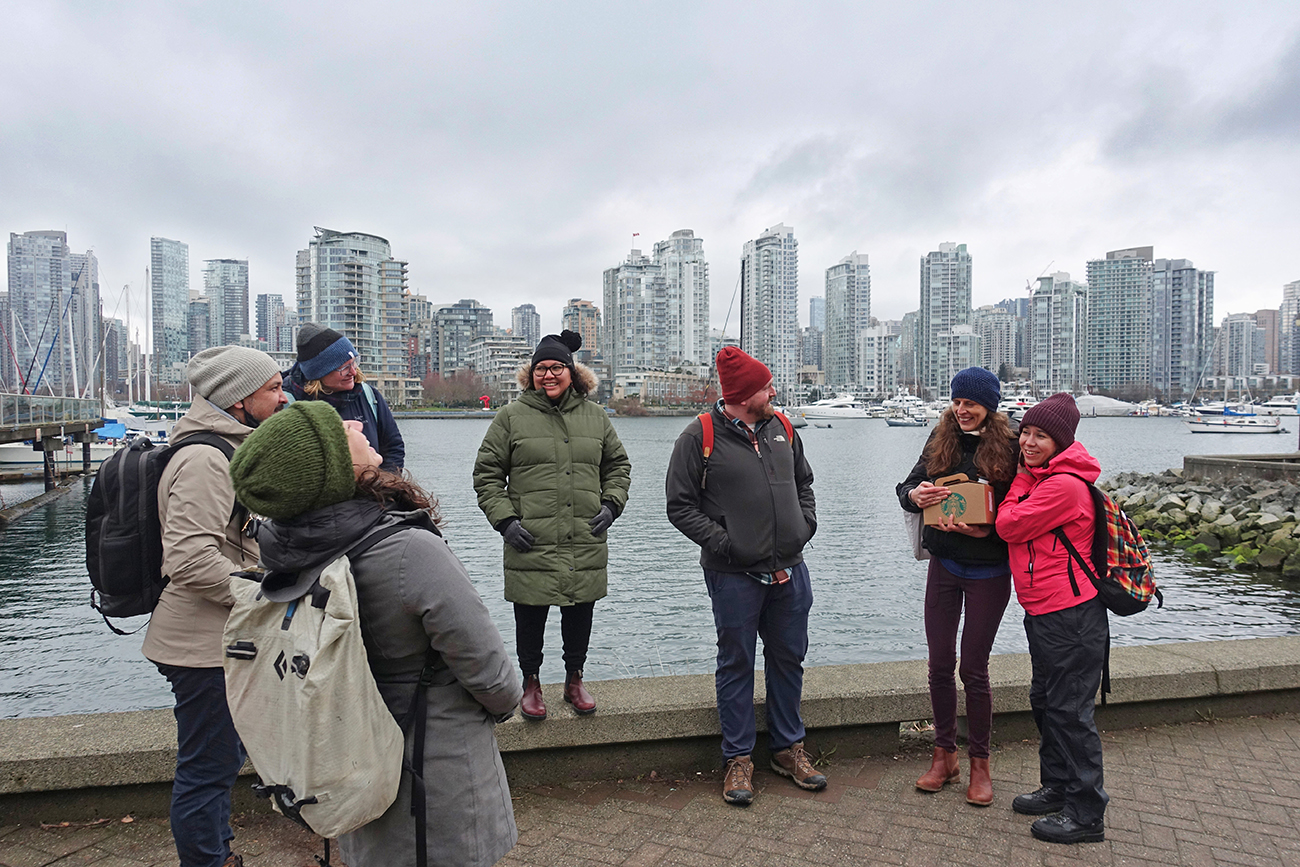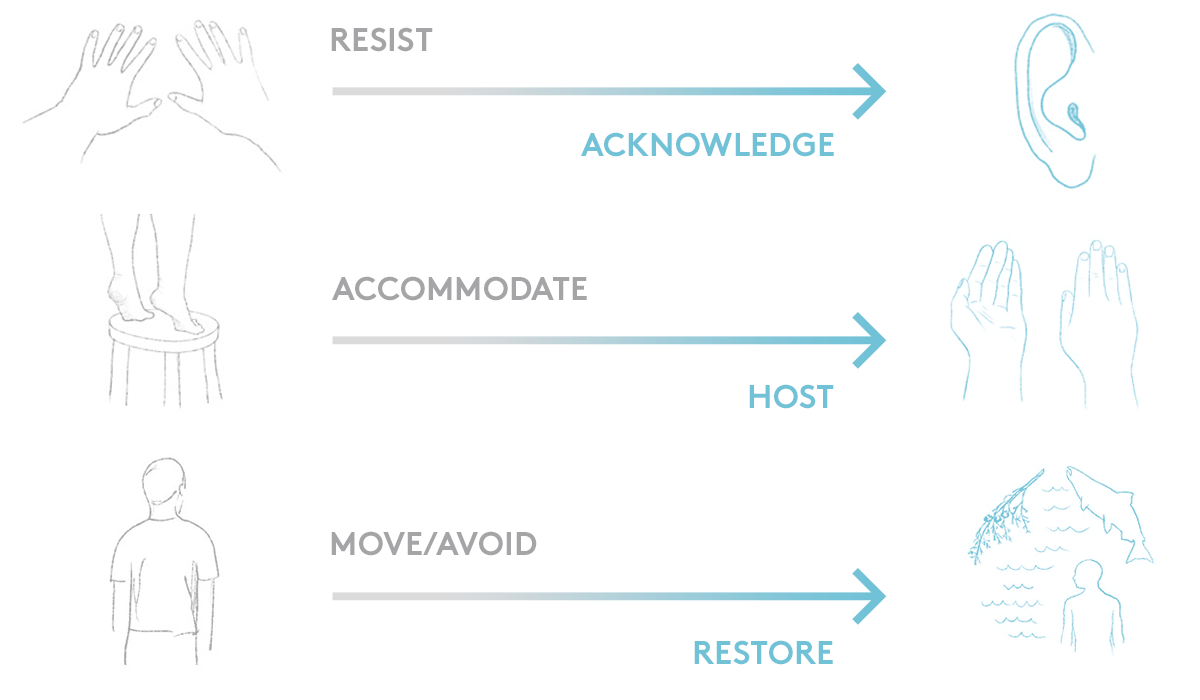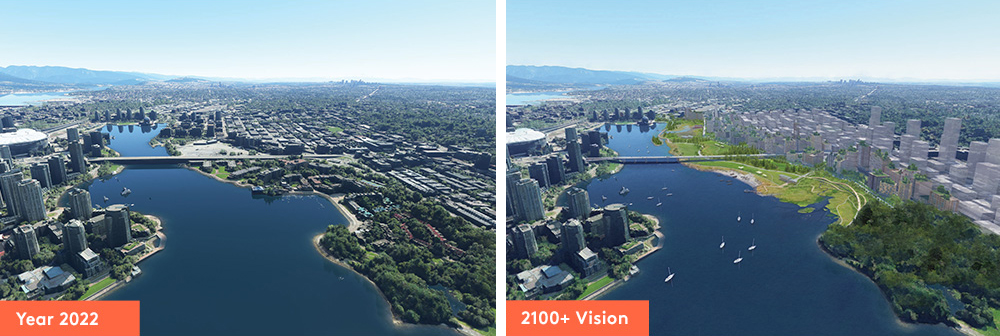Date Posted: 03.12.2023
The Mithun+One team worked with the City of Vancouver, Cultural Advisor Cory Douglas and Tsleil-Waututh Knowledge Keeper Charlene Aleck, on the Sea2City Design Challenge to explore exciting and pragmatic design concepts that respond to the challenges posed by sea level rise and coastal flooding along False Creek. From 2020 to 2023, the City engaged in community conversations, facilitated a Youth Adaptation Lab, co-hosted decolonization and indigenous perspectives workshops with Host Nations and brought together designers including the Mithun+One team to co-create a long-term vision for False Creek. This work highlights a collaborative and decolonized approach to coastal adaptation planning, defining a vision that intentionally responds to the stories, knowledge and values that were shared with the team from xʷməθkʷəy̓əm (Musqueam), Sḵwx̱wú7mesh (Squamish), and səlilwətaɬ (Tsleil-Waututh) perspectives. Through this process, the team has had the opportunity to explore what it means to decolonize a design and planning process and reflect on those learnings along the way.
In 2015 Canada adopted a Truth and Reconciliation Calls to Action to “redress the legacy of residential schools and advance the process of Canadian reconciliation.” The City of Vancouver’s reconciliation efforts with Host Nations focus on action items under three themes: healthy communities and wellness, achieving indigenous human rights and recognition, and advancing awareness, knowledge and capacity.

Conversations with Cory Douglas and Charlene Aleck, the team’s Cultural Advisors, provided the inspiration that guided the process and vision.
The framework for the City’s Sea2City Design Challenge is rooted in this commitment to truth and reconciliation with First Nations and urban Indigenous communities. The City prompted participating teams to center decolonization by working closely with a cultural advisor and knowledge keeper, and hearing from Musqueam, Squamish, and Tsleil-Waututh peoples in multiple Decolonization and Indigenous Perspectives workshops. Many themes and priorities emerged from these conversations that prompted ways to continue to learn, evolve and decolonize our design practice.
DESIGN IS ABOUT LISTENING
Instead of listening to validate ideas, listening is about letting the conversations, stories and learnings guide the outcomes. Often, cultural and traditional knowledge is used to inform predetermined design outcomes. Shifting that process to allow the design outcomes to be shaped by centering traditional knowledge and values creates a different set of outcomes. When conversations and stories are the driver in the design process, the design response stays flexible and open enough to allow the space and time for trust and authentic relationships to be developed. Approaching and addressing the issues with an open mind and an open heart changes the way that planning and design is done.

Working with cultural advisors and the City, and across both design teams, new language was used to describe coastal adaptation strategies. Instead of traditional language that exerts human dominance over natural processes, the language shifted to convey strategies that embrace change over time and celebrate the places where land and water intersect.
UNDERSTANDING RECIPROCITY
The importance of reciprocity emerged through building relationships and learning from First Nations Knowledge Keepers. Reciprocity is often seen in the context of achieving balance or compromise. Putting balance and compromise into the context of time immemorial and the ongoing impacts of colonization on First Nations Peoples prompts considering: What has already been given and what has already been taken? In planning for future generations, consideration of the impacts and harms of past generations is a primary goal so time was taken throughout the project to make space for intentional reflection. This encouraged discussion of questions with answers that changed as understanding deepened throughout the process: What does shared stewardship and co-management look like? What does Land Back look like? What interim steps are needed to get there?
THE IMPORTANCE OF THE SPOKEN WORD AND STORYTELLING
The project deliverables that came from this work, including a written report, have an important role in the City’s planning process. However, communicating with the written word and with data uses a traditional Western lens, often omitting subtle complexities which are left unstated. What is communicated through an analytical approach is very different than what is gained through the act of storytelling, listening and engaging in conversation. The deep connections and emotions that storytelling taps into are not easily replicated in written reports. Bringing lived experiences, including those of pain and trauma as well as hope and resilience, is critical to compel a different path forward and demonstrates the difference between a process that emphasizes decolonization and one that works towards realized outcomes of a decolonized False Creek.
WORKING TOWARD DECOLONIZED OUTCOMES
Early in the process the Mithun+One team asked: What does a decolonized False Creek look like?
This question emerged from a conversation with the team’s cultural advisors, who shared that the False Creek shoreline bears no resemblance to the native coasts of these lands. The edge is hardened with concrete, the trees are not native, and the tidal ecosystems have been filled in and developed upon. A decolonized shoreline removes historic fill, shifts development upland where it is naturally protected from sea level rise and introduces nature-based strategies that would bring back healthier creeks and tidal ecosystems to help clean contamination and reconnect people with the abundance of marine life and daily tidal changes.

The vision for a decolonized False Creek is one that reframes the city’s relationship with the shoreline, the processes that shape it, and how it is inhabited.
Alongside cultural advisors, the team imagined a place where the Musqueam, Squamish and Tsleil-Waututh Nations can practice, celebrate, share their cultures, and co-manage the landscape as a part of an ongoing conversation with the City of Vancouver. In this landscape that they have stewarded since time immemorial, False Creek can once again be a place where they can see themselves and their values and knowledge represented. The future of False Creek is a place for all people, creatures and diverse plant species to cohabitate. It represents a place of shared values, natural abundance, and optimism about the human role in helping heal the land and water for future generations.

Vision for Stamps Landing
Learn more about the Sea2City Design Challenge via the City of Vancouver website, and the Mithun+One team’s final South False Creek Coastal Adaptation Design Report.